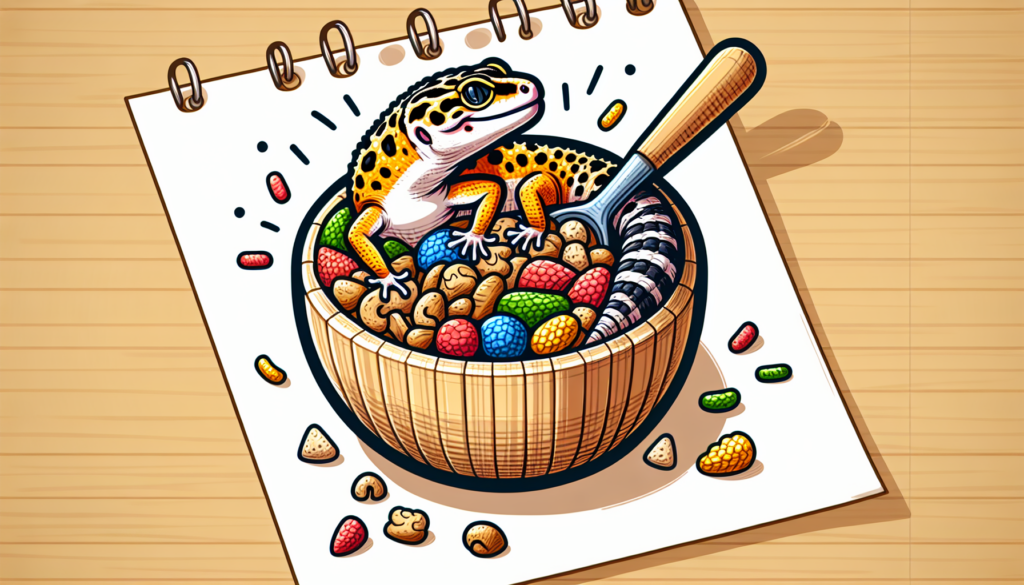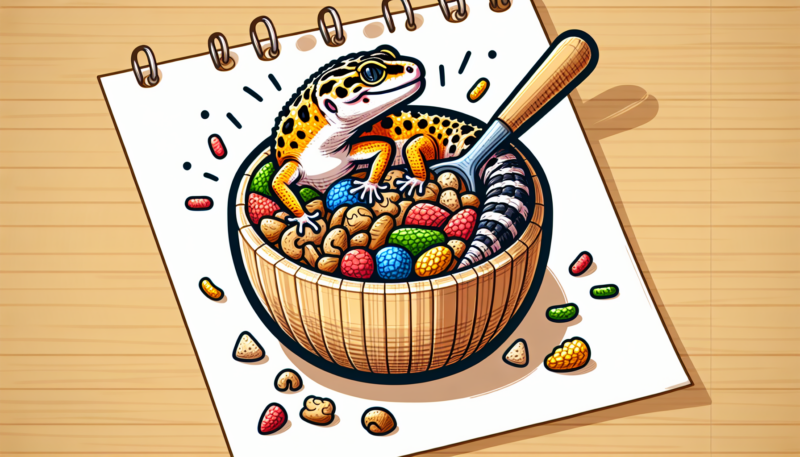Have you ever wondered what food to give your leopard gecko? Look no further! Introducing GARGEER Leopard Gecko Food, the perfect solution for your gecko’s nutritional needs. With its carefully curated formula, this food is designed to provide all the essential nutrients to keep your gecko healthy and happy. Say goodbye to the hassle of searching for the right food, and give your leopard gecko the best with GARGEER Leopard Gecko Food.

Overview of GARGEER Leopard Gecko Food
GARGEER Leopard Gecko Food is a specially formulated diet designed to meet the nutritional needs of leopard geckos. It is a complete and balanced diet that provides all the essential nutrients for their growth, development, and overall health. This high-quality gecko food is made with a variety of ingredients that mimic the natural diet of leopard geckos in the wild, ensuring that they receive the necessary nutrients for optimal health.
What is GARGEER Leopard Gecko Food?
GARGEER Leopard Gecko Food is a commercially available diet specifically formulated for leopard geckos. It is made from a combination of quality protein sources, a variety of vitamins and minerals, and natural additives and supplements that are essential for the well-being of these reptiles. This gecko food is a convenient and easy option for leopard gecko owners, as it eliminates the need to hunt for live insects or prepare complicated homemade diets.
Benefits of Using GARGEER Leopard Gecko Food
Using GARGEER Leopard Gecko Food offers several benefits for both leopard geckos and their owners. Firstly, it ensures that leopard geckos receive a nutritionally balanced diet, eliminating the risk of nutrient deficiencies. This can lead to better overall health, improved growth, and enhanced vitality in geckos. Secondly, GARGEER Gecko Food is a cost-effective option compared to constantly purchasing live insects. It also saves time and effort that would be spent on hunting for insects or preparing homemade diets. Lastly, GARGEER Leopard Gecko Food provides peace of mind, knowing that your gecko is getting all the essential nutrients it needs for a healthy life.
Understanding the Nutritional Needs of Leopard Geckos
Leopard geckos have specific nutritional requirements that must be met to maintain their health. They are insectivorous reptiles and require a diet high in protein. In the wild, their diet primarily consists of insects such as crickets, mealworms, and dubia roaches. However, it is essential to provide a varied diet that includes other protein sources, vitamins, and minerals. Calcium and vitamin D3 are particularly important for leopard geckos to prevent metabolic bone disease. GARGEER Leopard Gecko Food is designed to meet these nutritional needs, ensuring that your gecko thrives in captivity.
Ingredients in GARGEER Leopard Gecko Food
Quality Protein Sources
GARGEER Leopard Gecko Food contains high-quality protein sources such as insects, including crickets, mealworms, and black soldier fly larvae. These protein sources provide the essential amino acids that leopard geckos require for growth, tissue repair, and overall development. The protein content in the gecko food is carefully balanced to provide optimal nutrition without overloading the gecko’s system.
Variety of Vitamins and Minerals
To ensure that leopard geckos receive a well-rounded diet, GARGEER Leopard Gecko Food includes a range of vitamins and minerals. These essential nutrients help support various bodily functions, including immune function, bone health, and metabolism. The gecko food contains vitamins A, C, and E, as well as minerals like calcium, phosphorus, and iron.
Natural Additives and Supplements
GARGEER Leopard Gecko Food incorporates natural additives and supplements to enhance the nutritional value of the diet. These additives may include spirulina, bee pollen, and probiotics, which provide additional vitamins, minerals, and beneficial gut bacteria. These supplements contribute to the overall well-being and digestive health of the geckos.
Avoiding Harmful Ingredients
GARGEER Leopard Gecko Food is formulated without the addition of harmful ingredients such as artificial preservatives, colors, or flavors. It is free from fillers and other unnecessary additives that could potentially have negative effects on your gecko’s health. The gecko food is carefully crafted to provide a nutritious and safe diet for leopard geckos.
Feeding Frequency and Schedule
Determining the Age and Size of Your Gecko
Before establishing a feeding schedule, it is important to determine the age and size of your leopard gecko. Juveniles and adults have different nutritional requirements, and their feeding schedules may vary accordingly. Age and size are crucial factors in determining the appropriate amounts and frequency of feeding.
Different Feeding Requirements for Juveniles and Adults
Juvenile leopard geckos have higher growth and energy needs than adults. They require more frequent feedings to support their rapid development. Generally, juveniles should be fed daily, while adults can be fed every other day or every few days. It is essential to monitor your gecko’s growth and adjust the feeding schedule accordingly to ensure they are receiving adequate nutrition without becoming over or underfed.
Meal Size and Frequency Guidelines
The size of the meals provided to leopard geckos should be appropriate for their age and size. Juveniles may require smaller, more frequent meals, while adults can handle larger portions less frequently. As a general guideline, offer geckos a portion of food equivalent to the size of their head. This ensures that they can easily consume the food without risking choking or digestive issues.
Monitoring and Adjusting Feeding Schedule
Regularly monitor your leopard gecko’s weight and body condition to determine if any adjustments need to be made to their feeding schedule. If your gecko is maintaining a healthy weight and body condition, it indicates that the feeding schedule is appropriate. However, if your gecko is gaining too much weight or becoming underweight, you may need to adjust the feeding frequency or portion sizes accordingly. It is crucial to find the right balance to ensure your gecko’s nutritional needs are met.

Preparing GARGEER Leopard Gecko Food
Recommended Tools and Equipment
To prepare GARGEER Leopard Gecko Food, you will need a few essential tools and equipment. These include a clean mixing bowl, measuring spoons, a blender or food processor, and storage containers. It is essential to use tools that are designated for the preparation of your gecko’s food to maintain hygiene and prevent cross-contamination.
Step-by-Step Guide for Food Preparation
- Start by measuring the appropriate amount of GARGEER Leopard Gecko Food according to your gecko’s age and size. Consult the packaging for recommended portion sizes.
- Place the measured food into the mixing bowl.
- Add the recommended amount of water or liquid supplement as instructed on the packaging.
- Mix the food and liquid together thoroughly until it forms a consistent paste.
- Transfer the mixture to storage containers and refrigerate if necessary.
- Serve the prepared GARGEER Gecko Food to your leopard gecko by placing a small portion in its feeding dish.
Safety Precautions and Hygiene Practices
When preparing GARGEER Leopard Gecko Food, it is crucial to follow safety precautions and practice good hygiene. Always wash your hands before and after handling the food to prevent the transmission of harmful bacteria. Additionally, ensure that all tools and equipment used for food preparation are cleaned thoroughly before and after each use. This helps prevent contamination and keeps your gecko’s food fresh and safe for consumption.
Alternative Feeding Options
Live Insects as a Supplement
While GARGEER Leopard Gecko Food provides a complete and balanced diet, some leopard geckos may benefit from the addition of live insects to their diet. Live insects can be offered as occasional treats or as a supplement to the gecko food. Crickets, mealworms, dubia roaches, and silkworms are all suitable options for leopard geckos. It is important to ensure that any live insects provided are gut-loaded, meaning they have been fed a nutritious diet before being offered to your gecko.
Fresh Fruits and Vegetables
Fresh fruits and vegetables can be offered as occasional treats or as part of a balanced diet for leopard geckos. However, it is important to note that leopard geckos are primarily insectivores and have specific dietary requirements. Fruits and vegetables should not make up the majority of their diet but can provide added variety and enrichment. Some suitable options include small pieces of banana, mango, carrot, and leafy greens like kale or spinach.
The Role of Calcium and Vitamin D3 Supplements
Leopard geckos require adequate calcium and vitamin D3 to prevent metabolic bone disease and ensure proper bone development. While GARGEER Leopard Gecko Food is formulated to provide these essential nutrients, additional supplementation may be necessary, especially for geckos that do not receive sufficient UVB exposure. Calcium and vitamin D3 supplements can be dusted onto live insects or sprinkled on GARGEER Gecko Food to ensure geckos receive the necessary amounts.
Common Feeding Issues and Solutions
Refusal to Eat GARGEER Food
Some leopard geckos may initially refuse to eat GARGEER Leopard Gecko Food. This can be due to their natural instinct to prefer live prey or a reluctance to try something new. If your gecko refuses to eat the gecko food, you can try offering it alongside live insects or disguising it by mixing it with a small amount of their preferred food. Over time, most geckos will accept GARGEER Gecko Food as a regular part of their diet.
Digestive Problems and Dietary Adjustments
Leopard geckos can experience digestive problems if their diet is not balanced or if they are overfed. If you notice any signs of bloating, diarrhea, or constipation, it may be necessary to adjust their diet. Providing smaller meal portions and ensuring a varied diet can help alleviate digestive issues. If problems persist, consult with a reptile veterinarian for further guidance.
Addressing Overfeeding or Underfeeding
Maintaining an appropriate feeding schedule is crucial to prevent overfeeding or underfeeding. Overfeeding can lead to obesity and related health issues, while underfeeding can result in malnutrition and stunted growth. Regularly monitor your gecko’s weight and adjust the feeding schedule accordingly to ensure they are receiving the right amount of food for their size and age. If you are unsure, consult with a reptile veterinarian for guidance.
Handling Picky Eaters
Some leopard geckos can be picky eaters and may refuse certain types of food. If your gecko consistently rejects specific food items, it is important to offer a varied diet to ensure they are receiving all the necessary nutrients. Experiment with different food options and observe your gecko’s preferences. If pickiness persists, consult with a reptile veterinarian for further advice.
Resolving Nutritional Deficiencies
Identifying Signs of Nutritional Deficiencies
Nutritional deficiencies in leopard geckos can manifest in various ways. Common signs include weight loss, decreased appetite, lethargy, bone deformities, and poor reproductive health in females. If you notice any of these signs, it is essential to address them promptly to prevent further complications. Regular veterinary check-ups and monitoring your gecko’s weight and overall condition are key in identifying and resolving nutritional deficiencies.
Supplementing with Additional Nutrients
To resolve nutritional deficiencies, additional supplementation may be necessary. This can include providing calcium and vitamin D3 supplements, as well as offering a varied diet that includes high-quality protein sources, fruits, and vegetables. Consulting with a reptile veterinarian can help determine the specific nutrients your gecko may require for optimal health and the appropriate supplementation regimen.
Consulting a Veterinarian for Complex Cases
In complex cases of nutritional deficiencies, consulting with a reptile veterinarian is highly recommended. They can perform tests to assess your gecko’s overall health and identify specific nutrient deficiencies. A veterinarian can provide guidance on dietary adjustments, recommend appropriate supplements, and monitor your gecko’s progress over time.
Transitioning from Other Foods to GARGEER
Gradual Transitioning Process
When transitioning your leopard gecko from other foods to GARGEER Leopard Gecko Food, it is important to do so gradually. Abrupt changes in diet can cause digestive upset and refusal to eat. Start by offering a small portion of GARGEER Gecko Food alongside their current diet. Over time, gradually increase the proportion of gecko food while decreasing the amount of their previous diet until they are fully transitioned to GARGEER Gecko Food.
Introducing GARGEER as a New Diet
If you are introducing GARGEER Leopard Gecko Food to a new leopard gecko, it is generally easier as they have not developed strong preferences for other foods yet. Offer GARGEER Gecko Food as their primary diet from the beginning to establish healthy eating habits. It may take a few feedings for them to become accustomed to the new food, but with patience and consistency, they will readily accept it as their main diet.
Tips for Encouraging Acceptance
To encourage acceptance of GARGEER Leopard Gecko Food, consider the following tips:
- Offer the food in a separate feeding dish to distinguish it from other foods.
- Make sure the gecko food is fresh and smells appealing to entice your gecko to eat it.
- Experiment with different feeding methods, such as offering the gecko food on feeding tongs or placing it directly in front of your gecko to mimic prey movement.
- If your gecko is reluctant to try the gecko food initially, try feeding it during its active hours, when it is more likely to be hungry and curious.
- Monitor your gecko’s acceptance and adjust the transitioning process as needed. Some geckos may take longer to switch to a new diet, so patience is key.
Storing and Shelf Life of GARGEER Leopard Gecko Food
Proper Storage Techniques
To ensure the freshness and quality of GARGEER Leopard Gecko Food, it is important to store it correctly. Always follow the packaging instructions for storage recommendations. Typically, gecko food should be stored in a cool, dry place away from direct sunlight. It is best to keep it in a sealed container or the original packaging to prevent moisture or insect contamination.
Checking Expiry Dates and Quality
Before using GARGEER Leopard Gecko Food, check the expiry date to ensure it is within the recommended timeframe. Expired gecko food may lose its nutritional value and could potentially harbor harmful bacteria. Additionally, always inspect the gecko food for any signs of mold, unusual odor, or discoloration. If you notice any abnormalities, it is best to discard the food and obtain a fresh batch.
Avoiding Contamination and Spoilage
To prevent contamination and spoilage of GARGEER Leopard Gecko Food, it is crucial to follow good hygiene practices. Always handle the gecko food with clean hands and use clean utensils during preparation. Avoid cross-contamination by storing the gecko food separately from other pet food or human food. Additionally, ensure that the storage containers are properly cleaned and dried before refilling with fresh gecko food.
Conclusion
GARGEER Leopard Gecko Food is a reliable and convenient option for keeping your leopard gecko healthy and well-nourished. With its carefully formulated ingredients, GARGEER Gecko Food provides a nutritionally balanced diet that meets the specific needs of leopard geckos. By following the recommended feeding guidelines, preparing the food properly, and offering a varied diet, you can ensure that your gecko receives all the essential nutrients it needs for a long and vibrant life. Remember to consult with a reptile veterinarian for personalized advice and to address any specific concerns regarding your leopard gecko’s nutrition. With GARGEER Leopard Gecko Food, you can provide your gecko with optimal nutrition and enjoy watching them thrive in your care.
